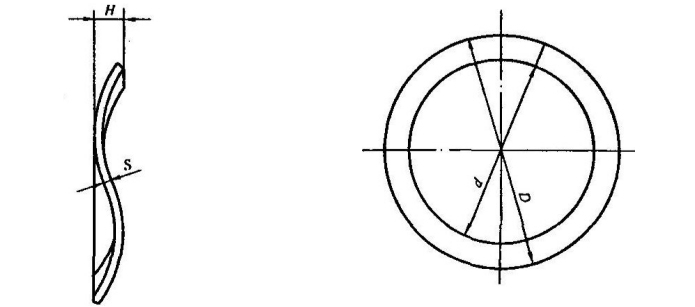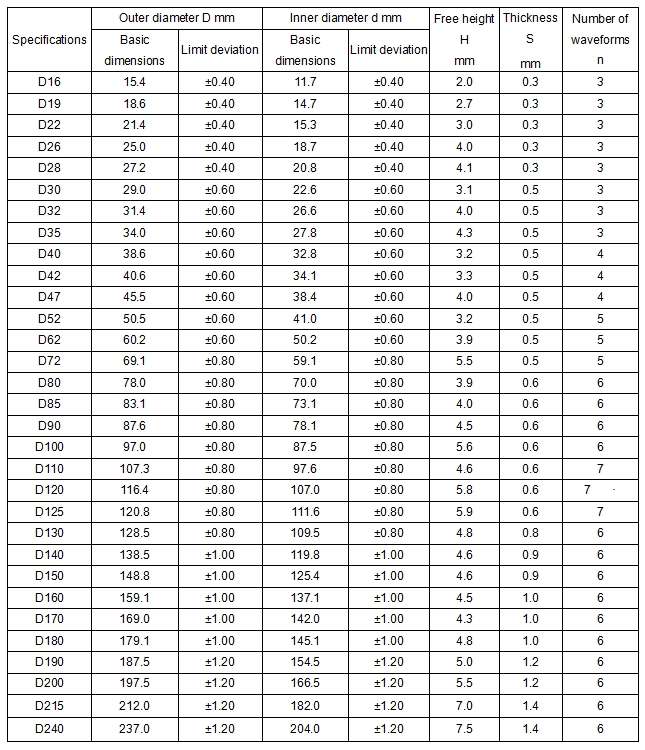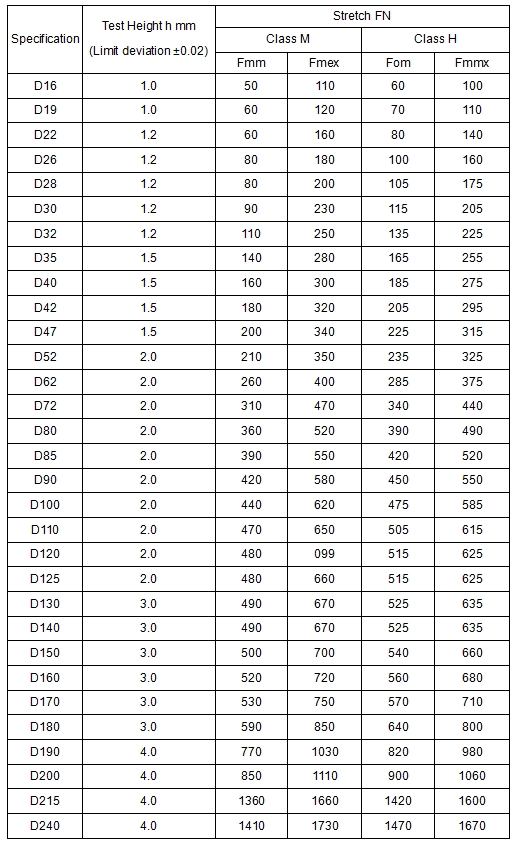- This topic is empty.
-
AuthorPosts
-
This standard is a revision of JB/T 7590-1994 "Technical Conditions for Steel Wave Springs for Motors".
• Compared with JB/T 7590-1994, the main changes in this standard are as follows:
1. Specification coverage: The specification range of this standard is D16~D240, and the specification range of JB/T 7590-1994 is D32~D240.
2. The original 3.2 "Installation Dimensions" is changed to "Outline and Installation Dimensions".
3. Product characteristic values: The appearance and installation dimensions of this standard are different from JB/T 7590-1994, which facilitates the realization of elastic performance requirements without affecting use; this standard stipulates two levels of elastic performance requirements to adapt to Different manufacturers have product requirements and stipulate two marking methods for elasticity levels. JB/T 7590-1994 only stipulates one elasticity level.
4. Description of the elastic force test: This standard describes the working elastic force test specified in JB/T 7590-1994 as the elastic force test, and the working height specified in JB/T 7590-1994 as the test height.
• Detection of elasticity test: This standard stipulates that the height of elasticity test is H mm/3.
• This standard replaces JB/T 7590-1994.
• This standard is proposed by China Machinery Industry Federation.
• This standard is under the jurisdiction of the National Rotating Electrical Machine Standardization Technical Committee (SAC/TC26).
• This standard is drafted by Shanghai Electrical Apparatus Research Institute (Group) Co., Ltd., with Wuxi Yuxin Machinery Co., Ltd., Hebei Electric Co., Ltd., and Beijing Bijie Electric Co., Ltd. participating in the drafting.
• The main drafters of this standard: Huang Liming, Luo Xiaochen, Zhao Zhiyan.
• This standard was first published in December 1994, and this is the first revision.
Table of contents:
1 Scope
2. Normative reference documents
3. Structural type
4. Technical requirements
5. Test methods
6. Test methods
7. Logo and packaging
Technical specifications of steel wave springs for motors
1 Scope
This standard specifies the structural type, technical requirements, test methods, inspection rules, marking and packaging requirements for steel wave springs for motors (hereinafter referred to as wave springs).
This standard applies to the basic series of small and medium-sized asynchronous motors and their derivative series, and also applies to steel wave springs used in other equipment that require axial preload.
2 Normative reference documents
The provisions in the following documents become provisions of this standard through reference in this standard. For dated reference documents, all subsequent amendments (excluding corrigenda) or revisions do not apply to this standard. However, parties to an agreement based on this standard are encouraged to study whether the latest versions of these documents can be used. . For undated referenced documents, the latest edition applies to this standard.
▶ GB/T 90.1-2002 Fasteners Acceptance Inspection (idt ISO 3269: 2000)
▶ GB/T 191-2000 Pictorial marking for packaging, storage and transportation (eqv ISO 780: 1997)
▶ GB 755-2000 Rotating electrical machines Ratings and performance (idt IEC 60034-1: 1996)
▶ GB/T 2828.1-2003 Enumeration sampling inspection procedures Part 1: Batch-by-batch inspection sampling plan retrieved by acceptance quality limit (AQL) (ISO 2859-1: 1999, IDT)
GB/T 2829-2002 Periodic inspection counting sampling procedures and tables (applicable to inspection of process stability)
▶ YB/T 5058-1993 Spring steel, tool steel cold rolled strip
3 structural type
A wave spring is an elastic element with several wavy peaks and valleys on a metal sheet ring. Its shape is as shown below:

4 Technical requirements
4.1 Wave springs should comply with the requirements of this standard and be manufactured according to drawings and technical documents approved through prescribed procedures.
4.2 The on-site operating environment of the wave spring should comply with the regulations of GB755.
4.3 The heat treatment and surface treatment of wave springs shall be in accordance with the requirements of Table 1, and the material properties shall comply with the requirements of YB/T 5058.
Table 1
Material
Heat Treatment
Surface Treatment
Type
Brand number
Standard
Spring Steel
65Mn
YB/T 5058
Quenched and tempered, 45HRC~52HRC(process reference)
Oxidation
4.4 The surface of the wave spring should be smooth, free of rust, burrs, cracks and other defects, and the oxide layer should be uniform.
4.5 The wave curve of the wave spring should be approximately sinusoidal, the cross-section should not be curved, and each wave crest should be evenly distributed along the circumference.
4.6 The shape and installation dimensions of the wave spring should comply with the requirements in Table 2.
Table 2

4.7 The elastic force of the wave spring at the specified test height should comply with the requirements of the corresponding level in Table 3.
Table 3

4.8 After the elastic test of the wave spring, its elastic force should not be less than 90% of Fmin.
4.9 The wave spring is not allowed to break after passing the toughness test.
5 Test methods
5.1 The apparent quality of wave springs is judged by visual inspection and hand feel.
5.2 The shape and installation dimensions of the wave spring are measured with a vernier caliper and a micrometer with a gauge. The inner and outer diameters are measured at two points perpendicular to each other, and the average value is taken. The free height should be measured one by one at the middle diameter of each wave peak, and the average value is taken. .
5.3 Elasticity test
Place the wave spring between the two parallel plates of the testing machine, gradually apply the load until the distance between the two parallel plates reaches the test height specified in Table 3, and measure the elastic force at this time. The equipment used in the elastic test should eliminate the systematic errors caused by zero drift and select appropriate accuracy.
5.4 Elasticity test
Place the wave spring that has passed the elastic force test between the two parallel plates of the testing machine, gradually increase the load so that the distance between the two parallel plates reaches H mm/3, and maintain the load for 24 hours. Release the load and perform the spring test again.
5.5 Toughness test
Bend the wave trough of the wave spring around a ø8mm round rod to cover 1/4 of its circumference, and visually inspect its surface.
6 Inspection rules
6.1 Wave springs must pass the inspection before leaving the factory.
6.2 Wave spring inspection is divided into factory inspection and type inspection.
6.2.1 The factory inspection items of wave springs are:
a) Apparent quality (4.4);
b) Appearance and installation dimensions (4.6);
c) Elasticity test (4.7).
6.2.2 The wave spring type inspection items are:
a) Apparent quality (4.4);
b) Appearance and installation dimensions (4.6);
c) Elasticity test (4.7);
d) Elasticity test (4.8);
e) Toughness test (4.9).
6.3 Type inspection should be carried out in any of the following situations:
a) During the first trial production or small batch trial production by the manufacturer after identification and finalization;
b) When there are major changes in structure, materials and processes;
c) When there is a big difference between the factory inspection results and the previous type inspection results;
d) The wave springs produced in batches shall be randomly tested regularly, once a year.
6.4 Sampling methods and judgment rules
6.4.1 Classification of inspection items
It is divided into two types of inspection items: A and B.
Class A inspection items include elasticity test, elasticity test and toughness test;
Class B inspection items include apparent quality, appearance and installation dimensions.
6.4.2 Factory inspection
According to GB/T 2828.1, one-time sampling for normal inspection, Class A inspection items AQL = 1.5, IL = II; Class B inspection items AQL = 2.5, IL = II.
Factory inspection can also adopt the fixed sample inspection method of GB/T 90.1. AQL for Class A inspection items = 1.5 and AQL for Class B inspection items = 2.5. The arbitration shall be carried out according to GB/T 2828.1.
6.4.3 Type inspection
Sampling according to GB/T 2829, judgment level DL=II, 16 pieces are selected from each item, the same sample is allowed to be used for several tests in the order of 5.1~5.5, Class A inspection item RQL=30, A. =3,R. =4; Class B inspection items RQL=50, Ac=5, R=6.
7 Logo and packaging
7.1 Logo
It is composed of specifications plus elasticity grade suffix. When the elasticity grade is M level, the grade suffix can be omitted.
Example: A wave spring with specification D90 and elasticity level M is marked D90-M or D90.
7.2 The wave spring should be rust-proofed before packaging. The outer packaging should be in corrugated cartons, and it should be ensured that under normal storage and transportation conditions, it should not be rusted or damaged due to poor packaging within six months from the date of shipment.
7.3 There should be a product inspection certificate in each packaging box.
7.4 The words and signs on the outer wall of the packaging box should be clear and neat, with the following contents:
a) Name of manufacturer;
b) Name of receiving unit:
c) Wave spring model and product number:
d) Product quantity;
e) The net weight of the wave spring and the gross weight of the box;
f) Overall dimensions of the packaging box;
g) Date of production;
h) The words "Afraid of Rain" should be marked on the appropriate position of the packaging box, and the graphics should comply with the requirements of GB/T 191.
Raleigh Spring Elasticity Technology Co., Ltd was founded by the national standards writer and focuses on the R&D and manufacturing of wave springs. It has a complete production chain from raw materials to special equipment and product manufacturing. Used in the automotive industry, aerospace, elevator braking, machine tool spindles, rail transit, valves, power switches, oil drilling, shipbuilding, wind braking, chip IGBT, motors and other industries. Raleigh has served more than 3,000 industrial enterprises and always insists on providing the best products and technical solutions to every customer!
Raleigh Spring
wxam.assistant@marketingforce.com -
AuthorPosts